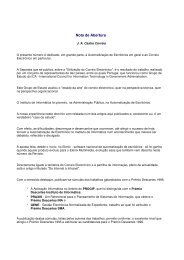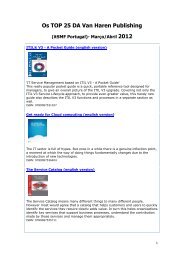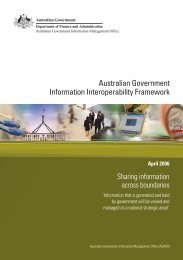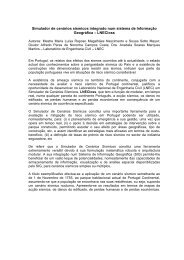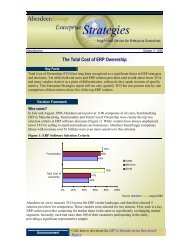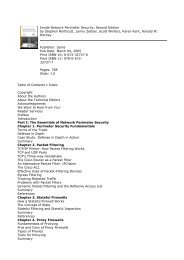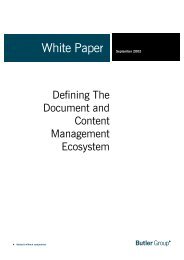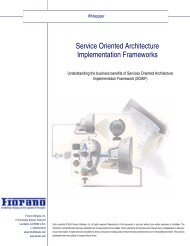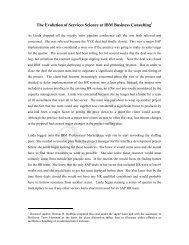OECD Peer Review of E-Government in Denmark - ePractice.eu
OECD Peer Review of E-Government in Denmark - ePractice.eu
OECD Peer Review of E-Government in Denmark - ePractice.eu
Create successful ePaper yourself
Turn your PDF publications into a flip-book with our unique Google optimized e-Paper software.
• Creation <strong>of</strong> a competitive market for the supply <strong>of</strong> ICT, with government be<strong>in</strong>g responsible<br />
for remov<strong>in</strong>g market failures.<br />
• The public sector hav<strong>in</strong>g a key role <strong>in</strong> promot<strong>in</strong>g national ICT development by us<strong>in</strong>g its<br />
<strong>in</strong>fluence as a consumer, and by provid<strong>in</strong>g e-government to both <strong>in</strong>dividuals and bus<strong>in</strong>esses.<br />
Based on these pr<strong>in</strong>ciples, government ICT policy currently has three major goals:<br />
• Creat<strong>in</strong>g growth <strong>in</strong> Danish bus<strong>in</strong>ess and <strong>in</strong>dustry.<br />
• Qualify<strong>in</strong>g Danes for the future knowledge society (<strong>in</strong>clud<strong>in</strong>g by <strong>of</strong>fer<strong>in</strong>g them a wider range<br />
<strong>of</strong> relevant and useful public services via the Internet).<br />
• Reform<strong>in</strong>g the public sector.<br />
Public sector reform is supported and enabled by us<strong>in</strong>g ICT to: 1) <strong>in</strong>crease public sector<br />
efficiency and productivity <strong>in</strong> provid<strong>in</strong>g coherent and user-focused public services; and 2) improve the<br />
<strong>in</strong>ternal organisation and operations <strong>of</strong> the public sector, and the way it <strong>in</strong>teracts with both citizens and<br />
bus<strong>in</strong>esses. This strong l<strong>in</strong>kage between Danish e-government and ICT policy is evidence <strong>of</strong> the fact<br />
that e-government has its orig<strong>in</strong>s <strong>in</strong> ICT policy, and also <strong>of</strong> the MVTU’s cont<strong>in</strong>ued close <strong>in</strong>volvement<br />
<strong>in</strong> e-government s<strong>in</strong>ce the creation <strong>of</strong> the Digital Task Force <strong>in</strong> 2001.<br />
There has been more success <strong>in</strong> build<strong>in</strong>g organisations’ understand<strong>in</strong>g <strong>of</strong> the relationship between<br />
e-government and government ICT policy than with public sector modernisation. Many <strong>in</strong>terviewees<br />
were able to chart the development <strong>of</strong> e-government from its beg<strong>in</strong>n<strong>in</strong>gs <strong>in</strong> the 1990s ICT policies,<br />
and most were very clear about the l<strong>in</strong>k between e-government and current ICT policies. In particular<br />
areas, such as development <strong>of</strong> the Danish “enterprise architecture” (see Chapter 6), the <strong>in</strong>terfaces<br />
between the two policy areas appear almost seamless, with <strong>of</strong>ficials clearly understand<strong>in</strong>g how one<br />
policy area contributes to the other. The survey data presented <strong>in</strong> Figure 4.4 <strong>in</strong> Chapter 4 shows that,<br />
after major <strong>in</strong>itiatives <strong>of</strong> the e-government programme such as eDay, the Danish enterprise<br />
architecture is one <strong>of</strong> the most significant drivers <strong>of</strong> e-government, be<strong>in</strong>g identified as “important” by<br />
30% <strong>of</strong> survey respondents. Given the highly technical nature <strong>of</strong> enterprise architecture, this is a<br />
significant result. It is also <strong>in</strong>terest<strong>in</strong>g to note that, ten years after its <strong>in</strong>ception, the 1995 IT action plan<br />
is still regarded as a significant driver <strong>of</strong> e-government by nearly 10% <strong>of</strong> survey respondents.<br />
Improv<strong>in</strong>g public sector efficiency<br />
There is a strong economic case for e-government based on the <strong>Government</strong>’s commitment to<br />
mak<strong>in</strong>g the public sector more efficient. The approach to address<strong>in</strong>g this challenge – laid out <strong>in</strong> 2000<br />
<strong>in</strong> a 10-year economic framework called A Susta<strong>in</strong>able Future – <strong>Denmark</strong> 2010 (“the 2010 plan”) – is<br />
to boost employment, restra<strong>in</strong> growth <strong>in</strong> public spend<strong>in</strong>g and reduce government debt. The public<br />
sector represents a large share <strong>of</strong> Danish GDP, provid<strong>in</strong>g over one-third <strong>of</strong> all jobs. Achiev<strong>in</strong>g<br />
improvements <strong>in</strong> the efficiency <strong>of</strong> the public sector will have an important impact on the future fiscal<br />
susta<strong>in</strong>ability <strong>of</strong> the welfare state.<br />
<strong>Denmark</strong> has recognised that, among other th<strong>in</strong>gs, achiev<strong>in</strong>g these goals requires public<br />
<strong>in</strong>vestment <strong>in</strong> the improved use <strong>of</strong> ICT <strong>in</strong> government. The importance <strong>of</strong> us<strong>in</strong>g e-government to<br />
achieve efficiency ga<strong>in</strong>s was heavily re<strong>in</strong>forced <strong>in</strong> the latest e-government strategy released <strong>in</strong> 2004.<br />
As shown <strong>in</strong> Figure 3.1, the e-government strategy identifies economic pressures (expressed as<br />
“limited resources”) as a major issue to be addressed by e-government. This challenge translates <strong>in</strong>to a<br />
number <strong>of</strong> strategic goals, most obviously the commitment to ensur<strong>in</strong>g that 75% <strong>of</strong> all digitalisation<br />
38



